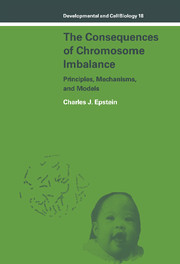Book contents
- Frontmatter
- Contents
- Preface
- Glossary
- PART I INTRODUCTION
- PART II CLINICAL OBSERVATIONS
- PART III THE THEORETICAL MECHANISMS AND ISSUES: THE PRIMARY AND SECONDARY EFFECTS OF ANEUPLOIDY
- 4 Gene dosage effects
- 5 Metabolic pathways, transport systems, and receptors
- 6 Regulatory systems
- 7 Assembly of macromolecules, cellular interactions, and pattern formation
- 8 Type and countertype
- 9 Nonspecific effects of aneuploidy
- PART IV EXPERIMENTAL SYSTEMS FOR THE STUDY OF MAMMALIAN AND HUMAN ANEUPLOIDY
- PART V THREE MAJOR CLINICAL PROBLEMS OF HUMAN ANEUPLOIDY
- PART VI CONCLUSION
- Appendix: Standard karyotypes of man and mouse and human cytogenetic nomenclature
- References
- Index
6 - Regulatory systems
Published online by Cambridge University Press: 14 October 2009
- Frontmatter
- Contents
- Preface
- Glossary
- PART I INTRODUCTION
- PART II CLINICAL OBSERVATIONS
- PART III THE THEORETICAL MECHANISMS AND ISSUES: THE PRIMARY AND SECONDARY EFFECTS OF ANEUPLOIDY
- 4 Gene dosage effects
- 5 Metabolic pathways, transport systems, and receptors
- 6 Regulatory systems
- 7 Assembly of macromolecules, cellular interactions, and pattern formation
- 8 Type and countertype
- 9 Nonspecific effects of aneuploidy
- PART IV EXPERIMENTAL SYSTEMS FOR THE STUDY OF MAMMALIAN AND HUMAN ANEUPLOIDY
- PART V THREE MAJOR CLINICAL PROBLEMS OF HUMAN ANEUPLOIDY
- PART VI CONCLUSION
- Appendix: Standard karyotypes of man and mouse and human cytogenetic nomenclature
- References
- Index
Summary
Theoretical considerations
Soon after the appearance of the work of Jacob and Monod (1961) on the regulation of gene expression in prokaryotes, attempts were made to explain the effects of aneuploidy on the basis of regulatory disturbance. Thus, Huehns et al. (1964) proposed two different regulatory models to explain the continued appearance of embryonic and fetal hemoglobins in the erythrocytes of patients with trisomy 13 (see below). Rohde (1965) generalized this notion to explain, at least in concept, the origin of the congenital anomalies associated with an aneuploid condition. However, his hypothesis invoked quantitative defects in the feedback regulation of induction or repression resulting from the aneuploidy-produced changes in metabolic pathways (secondary to changes in structural gene dosage) rather than a direct effect of aneuploidy on regulatory loci themselves (Rohde and Berman, 1963; Rohde, Hodgman, and Cleland, 1964). The latter was explicitly considered by Yielding (1967), who quoted data of Sadler and Novick (1965) showing that the presence of two copies of the lactose operon repressor locus in E. coli produced a 90% reduction in the already low levels of β-galactosidase present in uninduced cells containing only one repressor locus. This effect was eliminated when enzyme synthesis was induced, and a strict gene dosage effect could be observed under inducing conditions when an extra copy of the structural gene locus was also present (Fig. 6.1) (see also Luk and Mark, 1982).
- Type
- Chapter
- Information
- The Consequences of Chromosome ImbalancePrinciples, Mechanisms, and Models, pp. 113 - 145Publisher: Cambridge University PressPrint publication year: 1986



